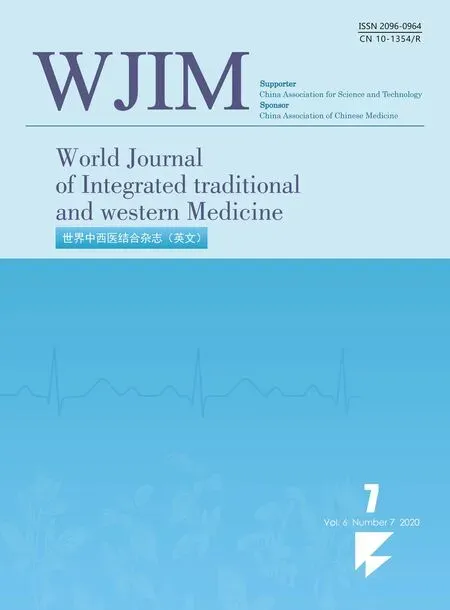Based on FP-Growth Algorithm to Excavate Medication Rule of Chinese Materia Medica for Radiation Esophagitis
2020-12-31ZHANGFupeng张福鹏ZHAOXiaoyan赵晓燕LIYifang李宜放HAOShulan郝淑兰WANGAirong王爱荣GUOBaishi郭白石LIULikun刘丽坤
ZHANG Fu-peng (张福鹏), ZHAO Xiao-yan (赵晓燕), LI Yi-fang (李宜放), HAO Shu-lan (郝淑兰),WANG Ai-rong (王爱荣), GUO Bai-shi (郭白石), LIU Li-kun (刘丽坤)
1. Shanxi Provincial Academy of Traditional Chinese Medicine/Shanxi Provincial Hospital of Traditional Chinese Medicine, Taiyuan 030012, China
2. Shanxi Provincial Hospital of Integrated Traditional Chinese and Western Medicine, Taiyuan 030013, China
3. Shanxi Fangzheng Information Technology Co., Ltd., Taiyuan, 030013, China
ABSTRACT Objective:To find the medication rule of Chinese materia medica for treating radiation esophagitis through FP-Growth algorithm. Methods:By searching the three major literature databases such as Chinese Journal Full-text Database, VIP Chinese Sci-tech Journals Database, Wanfang Data, etc. from the database establishment to May 10, 2020, 88 effective documents and 91 prescriptions were screened.The medication frequency of prescription in the paper was extracted and sorted. Results:The frequency of medicinal property from high to low were: slightly cold, cold, balance, warm, cool, slightly warm, and great cold. The frequency of medicinal taste from high to low were: sweet, bitter, pungent, slightly bitter,salty, slightly pungent, sour, light, astringent. The frequency of channel tropism from high to low were: lung,stomach, liver, heart, spleen, etc., and 10 herbal combinations with clinical significance were obtained.There was one prescription with good correlation strength in the clinical treatment of radiation esophagitis.Conclusion:The medication rule of Chinese materia medica for the treatment of radiation esophagitis is based on the principles of clearing away heat and detoxification, benefiting Qi (气) and nourishing Yin (阴), and stopping bleeding and removing phlegm. Heat-clearing medicine, tonic medicine, phlegmresolving, cough - relieving medicine and asthma-relieving medicine, blood-activating and stasis removing medicine were highly frequent used. The high-frequency association rules are nourishing Yin - clearing heat - generating fluid, removing toxin - cooling blood - benefiting Qi, benefiting Qi - invigorating spleen -stopping bleeding. It is stable and feasible to use FP-Growth algorithm to mine traditional Chinese medicine(TCM) to treat diseases.
KEYWORDS FP-Growth; Mining; Ridiation esophagitis; Chinese materia medica
Radiation esophagitis (RE) is a complication of lung cancer, esophageal cancer and other malignant tumors during radiotherapy. The incidence is about 1%-15%. It is mainly manifested as esophageal ulcers and even perforations. It is clinically presented as pain while eating[1]. Once perforation occurs,treatment will be delayed and even life-threatening.Therefore, it showed great clinical significance to actively treat RE to enable patients to pass the risk period of perforation.
The research on the pathogenesis of RE is mainly cytokine-mediated inflammation such as TNF-α, IL-1β, IL-6, IL-8[1-2]and the hypothesis of esophageal mucosal repair[3], but the treatment of RE is still not unified. Modern medicine takes the symptomatic treatment of antispasmodic and pain relief, anti-inflammatory and antibacterial, and protection of the gastrointestinal mucosa as the main treatment principles. Compared with symptomatic treatment, traditional medicine uses clearing away heat and drying dampness, replenishing Qi and nourishing Yin, promoting blood circulation, promoting Qi movement, and reducing swelling and generating muscle as syndrome differentiation therapy[1], which has achieved certain curative effects. This paper used the FP-growth algorithm to search the previous literature database and explore the prescription and medication rules, providing ideas and references for the treatment of RE with Chinese materia medica.
MATERIALS AND METHODS
The Source of Chinese Materia Medica Prescription
The three major literature databases including the Chinese Journal Full-text Database, VIP Chinese Sci-tech Journals Database, Wanfang Data were searched.
Search Strategy
In the three above-mentioned databases,the precise search was performed with the search formulas of "radiation esophagitis" and "Chinese medicine" or "Chinese materia medica" respectively,and the search period was set from the date of database establishment to May 10, 2020.
Inclusion and Exclusion Criteria
Inclusion criteria: 1. Clinical research literature with a clear diagnosis of RE (acute or chronic) were included; 2. The selected prescriptions have definite curative effects, all of which are decoctions for oral administration, and the prescription medicine composition, taste, and dosage are clearly recorded;3. The prescription of the same name but different units and different Chinese materia medica.
Exclusion criteria: 1. Clinical experience, case reports were excluded; 2. The purpose of treatment is not mainly RE; 3. The main therapeutic medicine is Chinese patent medicine were excluded; 4. Review paper were excluded; 5. Experimental and theoretical paper; 6. The same Chinese medicine compound but different journals were excluded; 7. Modification with accompanying symptoms.
Chinese Materia Medica Specifications
The aliases of prescription medicine should be unified as much as possible. For example,RadixRehmanniae Recens, andRadix Rehmanniae Recenswere all recorded asRadix Rehmanniae Recens;Rhizoma Pinelliae Preparata,Rhizoma Pinelliae Preparata, processedRhizoma Pinelliae,andRhizoma Pinelliaewere all recorded asRhizoma Pinelliaea.
Data Analysis
The "National Famous Chinese Medicine Inheritance Auxiliary Platform" software developed by Shanxi Provincial Institute of Traditional Chinese Medicine was used to analyze medicine statistics and prescription rules, and the FP-growth algorithm was used for data mining with four related indicators such as support, confidence, lift, and leverage, so as to cluster and extract the combinations of Chinese materia medica in the literature.
RESULTS
Search Results
A total of 219 papers were initially included,and abstracts were screened out according to the inclusion and exclusion criteria. Articles were screened out by reading abstracts. The full text was read and the EXCEL table of medication prescriptions was finally with 88 papers and 91 prescriptions (Figure 1).
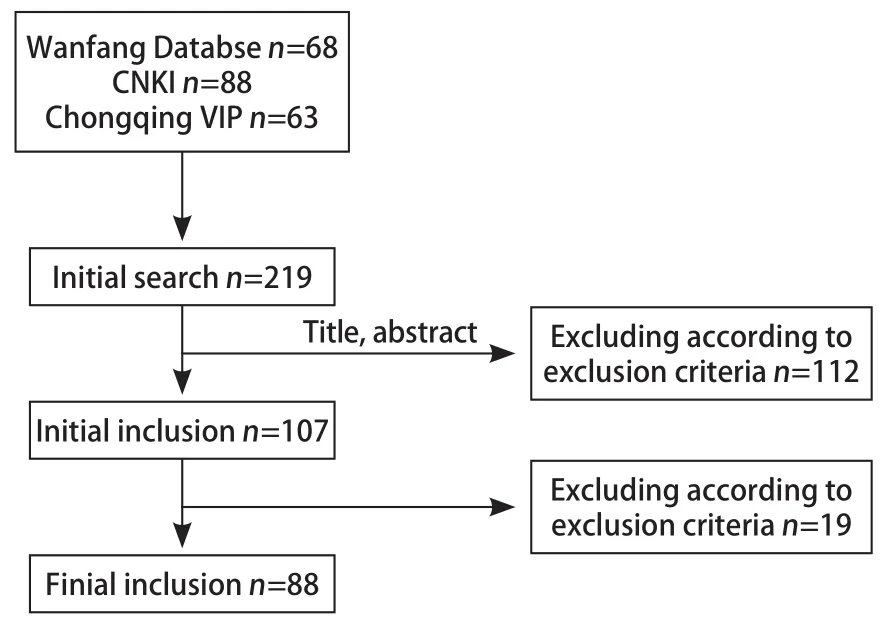
Figure 1. Document Retrieval Flowchart
Analysis of Medication Rule
For RE, 91 prescriptions of Chinese materia medica were collected from literature, involving 157 kinds of drugs.
Frequency of medication
The top 10 Chinese materia medica used for the treatment of RE includedRadix Glycyrrhizae,Radix Ophiopogonis,Radix Rehmanniae Recens,Flos Lonicerae,Radix Scrophulariae,Rhizoma Bletillae,Radix Platycodonis,Radix Sophorae Tonkinensis,Radix Astragali seu Hedysari, andRadix Trichosanthis, as shown in Figure 2. The frequency analysis was as follows (took the top 45 drugs according to frequency).
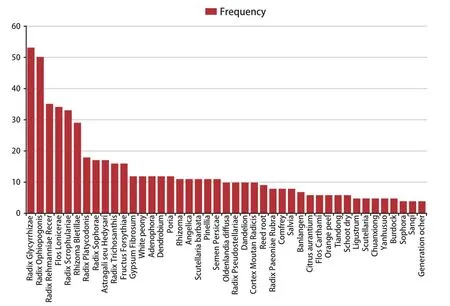
Figure 2. Frequency Analysis of Medication
Medicinal properties, taste and channel tropism
In the analysis of 157 herbs, the frequency of use of medicinal properties from high to low were:slightly cold, cold, balance, warm, cool, slightly warm, and great cold (Figure 3); the frequency of use of medicinal tastes from high to low were:sweet, bitter, pungent, slightly bitter, salty, slightly pungent, sour, light, and astringent (Figure 4); in the analysis of channel tropism, the use frequency of channel tropism in descending order were: lung,stomach, liver, heart, spleen, kidney, large intestine,small intestine, bladder, gallbladder, etc. (Figure 5).
Statistics of all herbs according to their efficacy
All herbs were analyzed according to their efficacy. The top 10 medicine with good efficacy included heat-clearing herbs, tonic herbs, phlegmrelieving, cough-relieving and asthma-reducing herbs, blood-activating and stasis-removing herbs, Qi-regulating herbs, diuresis and diffusing dampness herbs, superficies-relieving herbs,herbs for suppressing hyperactive liver for calming endogenous wind, herbs for resolving dampness with aromatics and rheumatism herbs (Figure 6).
Association analysis of all herbs based on FP-Growth algorithm
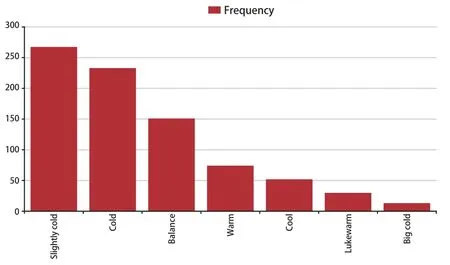
Figure 3. Analysis of Medicinal Properties
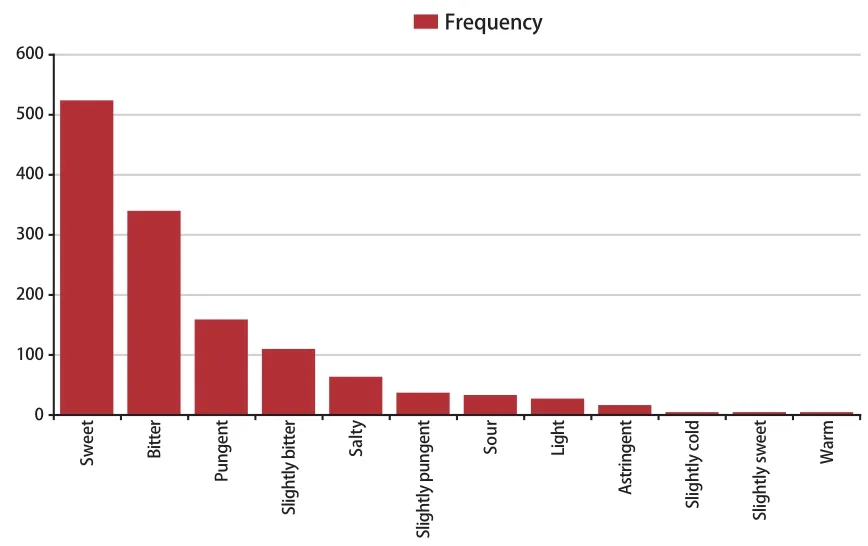
Figure 4. Analysis of Medicinal Taste
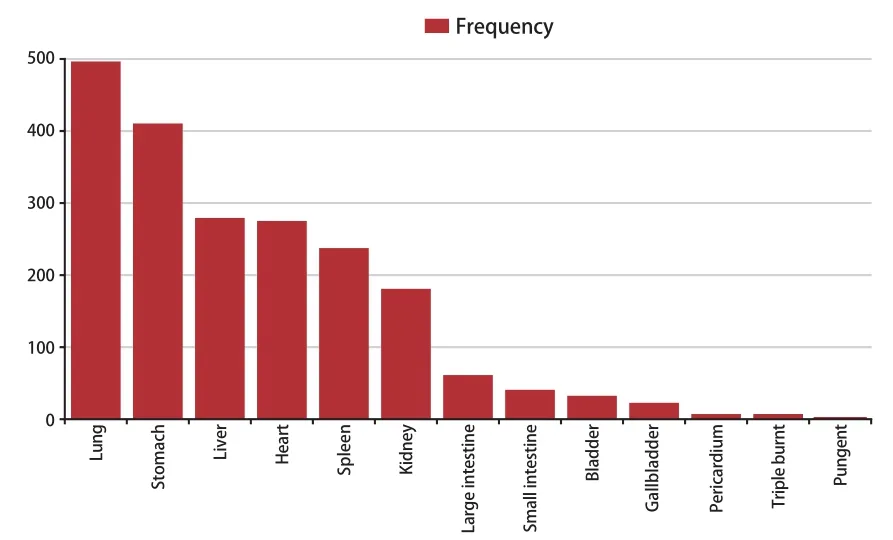
Figure 5. Analysis of Channel Tropism
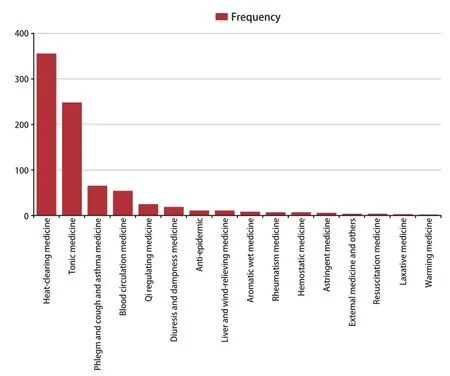
Figure 6. Analysis of Drug Efficacy
The FP-Growth algorithm was converted into a Force Atlas graph to visualize it, as shown in Figure 7. The size of the circle in the figure represents the frequency of the herb's appearance, and the curve represents the relationship between the herbs. The closer the distance between the two herbs, the closer the relationship. The more the central position is associated with other drugs.

Figure 7. Force Atlas Diagram
It can be seen from Figure 7 that 1 731 herbs association rules were obtained under this parameter, and repeated associations were eliminated and the association relationship was relatively small. The clinically significant association list was shown in Table 1, and 10 new herbs combination prescriptions were generated.
If the parameter settings are changed, the minimum support upper bound will be increased to 0.05, and the other parameters will remain unchanged, resulting in a new Force Atlas diagram(Figure 8, Figure 9).
DISCUSSION
Introduction to FP-Growth Algorithm
Data mining technology is widely used in the current medical field. The application of association rules in data mining to the interaction analysis of traditional Chinese medicine can promote the inheritance of traditional Chinese medicine (TCM)and rational use of medicine. The FP-Growth algorithm uses a tree storage structure. No candidatesets are generated in the process of finding frequent item sets. The data can be compressed into the FP-Growth algorithm by only scanning the database twice. If the prefix is the same, the path is also the same, so as to achieve the effect of data compression[1]. At present, the mining of Chinese medicine and Chinese materia medica mainly uses the Apriori algorithm for data mining and the study of formulating rules[1-2]. The FP-growth algorithm is different from the Apriori algorithm for generating candidate sets and then checking whether the frequent "generation-test" method, but uses a compact data structure called frequent pattern tree (FP-tree) to organize the data, and directly extracts frequent item sets from the structure. And in the case of less support, the FP-growth algorithm has more obvious advantages than the Apriori algorithm[1], and use four measures of confidence,lift, leverage and conviction to measure the degree of association of the rules.
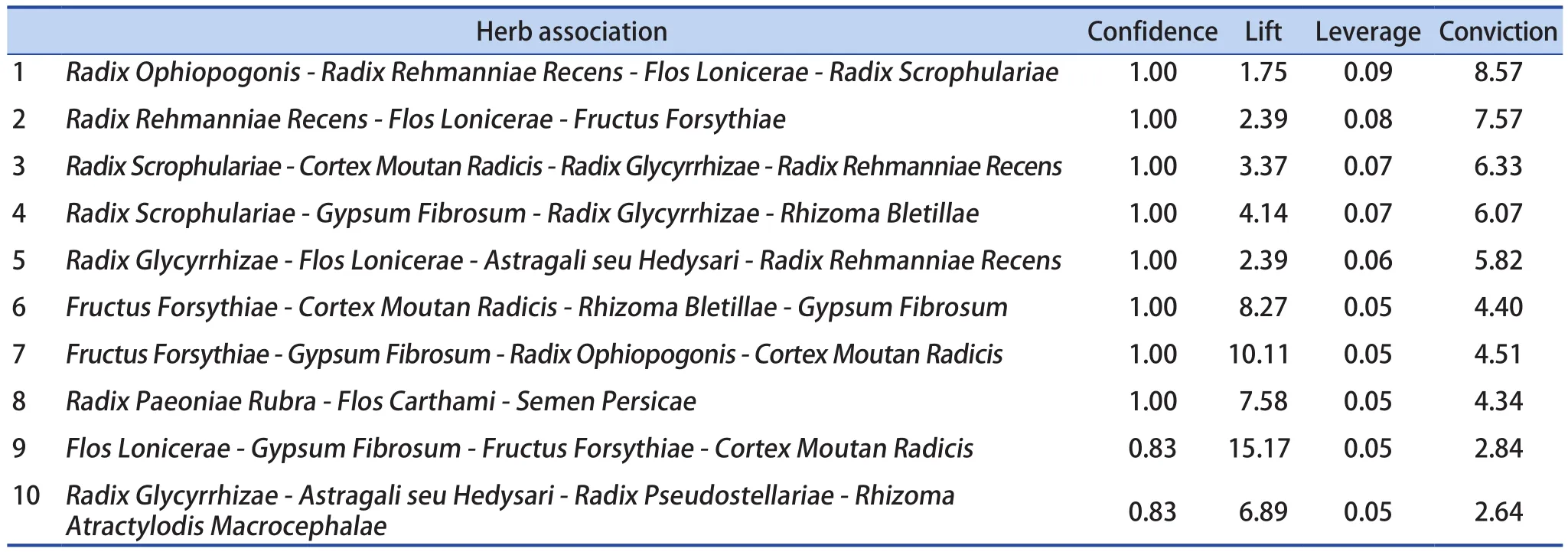
Table 1. Association List of Medicine
Association Rules of Chinese Materia Medica for RE
The only cause of RE is radiation fire and toxin pathogen. Its pathogenesis is fire and toxin damaging the body, causing excessive toxic heat and yin fluid consumption; or toxin damaging blood collaterals, and blood stasis internal resistance.Medication is mainly to clear heat and detox,nourish Yin and produce body fluid, promote blood circulation and remove blood stasis[1]. The differentiation of syndromes is based on the ideas obtained from the discussion and analysis of the doctors, or based on prescriptions[2]. The classification is of little significance, so this study did not analyze the syndrome types.
This study derives high-frequency herbs based on herb frequency and association rules. According to the clinical application and associated stability, the prescriptions for the treatment of RE, namelyRadix Rehmanniae Recens,Radix Scrophulariae,Radix Ophiopogonis,Flos Lonicerae,Fructus Forsythiae,Cortex Moutan Radicis,Rhizoma Bletillae,Astragali seu Hedysari,Herba Dendrobii,Radix Platycodonis,Gypsum Fibrosum,Radix Glycyrrhizae, was obtained. Among them, the medicinal composition of bitter cold, returning to the lung and stomach,clearing away heat and detoxification, nourishing Yin and Qi, resolving phlegm and stopping bleeding,not only conforms to the clinical principles and prescriptions, but also consistent with literature data reports.Radix Rehmanniae Recens,Radix Scrophulariae,Radix Ophiopogonisare Zengye Decoctions (增液汤). Through network pharmacology analysis, they may combine with the corresponding molecules of the biological organism to have catalytic and oxidative activities, and then exert the corresponding medicinal effects[1].Flos LoniceraeandFructus Forsythiaeare the commonly used herb pair for the treatment of febrile diseases,which is from Yinqiao Powder (银翘散) inDetailed Analysis of Epidemic Warm Diseases. Modern research[1]shows that the diseases are mainly inflammatory diseases and malignant tumors. After compatible use, it can clear away heat and detoxify and dispel wind and heat, and can achieve the purpose of anti-inflammatory by reducing the level of IL-6 in experimental rats[2].Rhizoma Bletillaehas the effect on growing muscles, curing sores, astringent and hemostasis,Rhizoma Bletillae's main chemical components bletillan, with form a layer of protective film on the wound surface, which can stimulate the proliferation of granulation tissue and promote wound healing[1].Astragali seu Hedysarican protect against oxidative stress in anti-X-rays by promoting superoxide dismutase to scavenge free radicals[1],and the treatment mechanism of RE is consistent.Gypsum Fibrosumwas first recorded inShennong's Classic of Materia Medicaand was classified as middle grade. It has the effects on clearing heat,purging fire, eliminating irritability and quenching thirst.Radix Platycodoniswas first seen inHerbal Classic. Zhang Yuansu in Jin Dynasty pointed out thatRadix Platycodonis"treats sore throat, promotes lung qi, cures nasal congestion", and is compatible with heat-clearing and detoxifying medicine mainly for guiding channel[1]. To sum up, the FP-Growth association rules are used to determine the proper compatibility of prescriptions, which is clinically popular.
CONCLUSION
To sum up, this project uses modern data methods to obtain the Chinese materia medica prescriptions in the literature database for the treatment of RE. The treatment principles are to clear away heat and detoxify, nourish Qi and Yin,stop bleeding and resolve phlegm. Heat-clearing medicine, tonic medicine, phlegm-resolving, coughrelieving medicine and asthma-relieving medicine,blood-activating and stasis removing medicine were highly frequent used. The high-frequency association rules are nourishing Yin - clearing heat - generating fluid, removing toxin - cooling blood - benefiting Qi, benefiting Qi - invigorating spleen - stopping bleeding. Combing with clustering combinations and drug usage trends, according to the specific disease and syndromes of clinical patients, it can be composed of focused and individualized selection of prescriptions, and effective prescriptions can be condensed on the basis of a large number of clinical trials, creating a "shortcut" for inheriting and developing Chinese medicine. However, the specific application methods of drugs and the pharmacological mechanism between combinations are not yet perfect, especially the rigor of clinical trials of traditional Chinese medicine still needs to be further strengthened.
猜你喜欢
杂志排行
World Journal of Integrated Traditional and Western Medicine的其它文章
- Rapid Recovery Strategy of Treating Hemorrhoids in Perioperative Period by Multimodal Analgesia with Traditional Chinese Medicine
- Effects of Medicated Bamboo Cupping Therapy of Zhuang Nationality Medicine on Long-term Efficacy and Quality of Life in the Treatment of Functional Dyspepsia with Stagnation of Liver Qi and Spleen Deficiency Syndrome
- Clinical Effects of the Qi-acupuncture Therapy of TCM on Portal Hypertension
- INSTRUCTION FOR AUTHORS
- A Review on Treating Postoperative Perianal Abscess by the TCM External Therapy
- Application Status of Infrarde Thermography in the Evaluation of Curative Effect of Traditional Chinese Medicine
